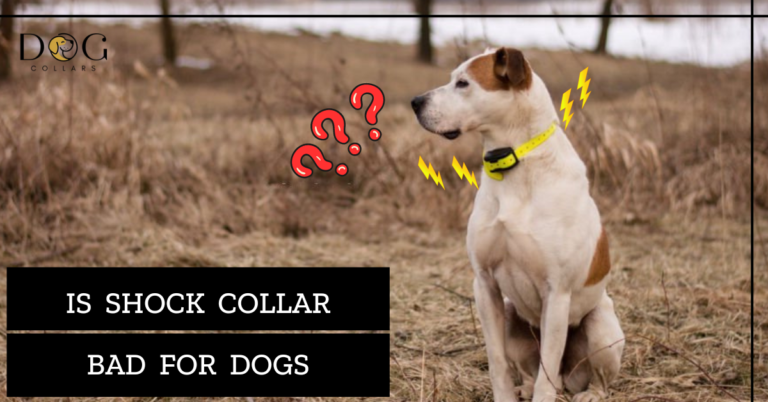How Do You Reset A Stubborn Dog Collar – 11 Simple Steps

Dealing with a stubborn dog collar? No worries, I’ve got your back! Let’s tackle this together and get that collar reset in a snap. Here’s how you can do it like a pro!
To reset a stubborn dog collar, locate the reset button on its receiver, use a thin tool to press and hold the button for a few seconds, wait for confirmation (usually a light or beep), and then test it before reattaching it to your dog.
Now, we’ll walk you through the simple steps on how do you reset a stubborn dog collar and get your pup back on track. Wait a minute! If you are using an old collar, you should consider buying a new stubborn dog collar and give your furry friend a surprise.
How Do You Reset A Stubborn Dog Collar – Step-By-Step Guide
Reset the collar may vary depending on the type and model. However, here is a general step-by-step guide that should work for most of the stubborn dog collars. These steps worked for the collar I am using for my dog. If you are interested, you can read a detailed review of the the stubborn electronic dog collars I personally use for my dog.
Step 1: Remove it from Your Dog
Ensure the collar is not on your dog before attempting to reset it. Also, remove the battery from the transmitter. This is essential for safety and to prevent accidental stimulation.
Step 2: Read the Manual
Familiarize yourself with the specific instructions for your product by reading the user manual provided by the manufacturer. Different collars may have unique reset procedures.
Step 3: Locate the Reset Button
Most electronic bands have a reset button. Look for a small hole or button on the collar’s receiver unit. It’s usually labeled “reset” or represented by a small circular depression.
Step 4: Power Off the Collar
Before proceeding, make sure the collar is turned off. If there’s a power switch, switch it off to ensure safety during any adjustments or resetting.
Step 5: Press and Hold Reset Button
You’ll need a thin tool, such as a paperclip, a ballpoint pen tip, or a toothpick, to press the reset button. Ensure the tool is clean and not sharp enough to cause any damage. Gently insert the tool into the reboot button’s hole and press and hold the button for a few seconds (usually around 5-10 seconds). Be patient, as some types may require a longer hold to reboot.
Step 6: Wait for Confirmation
After holding the reset button, you may notice a light or indicator on the collar flashing or changing color, or you might hear a beep. This indicates that the reboot process is taking place.
Step 7: Release the Button
Once you see or hear the confirmation signal, release the reset button.
Step 8: Test the Collar
Before putting it back on your dog, test it to ensure the reboot was successful. Follow the manufacturer’s instructions on how to test the collar. Usually, this involves holding the collar in your hand and activating it to see if it produces the correct response (a vibration, a tone, or a static stimulation).
Step 9: Reattach the Collar
If the test is successful, reattach it to your dog, ensuring it fits comfortably and securely.
Step 10: Monitor Their Behavior
Keep a close eye on how your dog reacts once they’re wearing their reboot neckband again. Look out for signs of discomfort like scratching excessively or trying to remove it themselves. Address any concerns promptly because every dog is unique and may require additional adjustments.
Step 11: Seek Professional Help if Necessary
If, despite all efforts, your dog continues to exhibit resistance or discomfort with their strap, it may be time to seek professional help.
Remember, always follow the specific instructions provided by the manufacturer for resetting your dog’s collar. If you encounter any difficulties consult the product’s manual or contact the manufacturer’s customer support for assistance.
Why Do Dog Collars Need To Be Reset?
Well, the answer lies in the importance of proper fit and comfort for our furry friends. Dog shock collars serve multiple purposes – identification, control, and safety. But over time, a choker can become loose or tight due to factors such as growth, weight loss or gain, or even wear and tear.
1. Proper Fit and Safety:
- Regular resetting ensures a snug fit, preventing dogs from slipping out of their collars during walks or playtime.
- Avoid discomfort: An ill-fitting strap can cause discomfort and even restrict breathing. Get your dog a large dog collar if it needs.
2. Accommodating Growth and Changes:
- Dogs grow and change: They need adjustments to accommodate growth spurts or weight fluctuations.
- Aging and behavior changes: As dogs age, their activity levels and behavior may change, affecting their neck measurement.
3. Wear and Tear:
- Wear and tear: Dogs’ explorative behavior can lead to fraying or stretching of their material.
- Optimal effectiveness: Resetting helps maintain its functionality and safety.
By regularly checking and rebooting, you ensure they have a comfortable and well-fitted accessory that supports their overall well-being.
What Type Of Collar Is Best For My Dog?
When it comes to choosing it for your dog, there are several options to consider. The type of collar that is best for your dog will depend on their specific needs and behavior.
1. Traditional Flat Buckle:
- Simple and effective: Provides a secure fit around your dog’s neck.
- Material options: Available in nylon or leather for your dog’s comfort.
2. Martingale:
- Great for pullers: Designed to tighten when tension is applied, preventing slipping or choking.
- Controlled and safe: Offers more control without excessive pressure.
3. Harness:
- For respiratory issues or neck injuries: Distributes pressure across the chest instead of the neck.
- Comfortable and secure: Harnesses are ideal for dogs needing extra support during walks.
4. Waterproof Collar:
- Water activities lovers: Made from materials like rubber or neoprene, durable and moisture-resistant.
- Long-lasting and practical: Perfect for dogs who enjoy outdoor adventures.
5. Head Halter Collar:
- Better control during walks: Gently redirects your dog’s attention and discourages pulling.
- Comfortable restraint: Provides control without causing discomfort.
Remember, each dog is unique, and their needs may change over time. Consider your dog’s individual requirements and consult professionals.
How Often Should I Reset My Dog’s Receiver Collar?
Rebooting your dog’s receiver collar depends on several factors, including the type of collar and your dog’s behavior. Here’s what you need to consider:
1. Traditional Buckle or Snap Collars:
- Generally, no frequent rebooting is needed for traditional buckle or snap collars.
- Check regularly: Ensure the strap is still secure and comfortable for your dog.
2. Electronic Training Collars:
- More frequent resetting: If using an electronic training collar with adjustable stimulation levels.
- Find the right level: To determine the appropriate stimulation level that effectively communicates with your dog without causing distress.
3. Changes in Weight or Size:
- Reboot when needed: If your dog experiences weight changes or growth, rebooting the collar may be necessary for a proper fit.
4. Individual Differences:
- Observe your dog: Each dog responds differently to collar settings.
- Adjust accordingly: Pay attention to their comfort level and behavioral needs to determine the right frequency of resetting.
Remember, your dog’s safety and comfort are paramount. Take the time to understand your dog’s unique requirements, and don’t hesitate to make adjustments to ensure a positive experience with their collar.
Tips and Tricks for Collar Training
It is an essential part of dog ownership, especially if you have a stubborn pup. Here are some tips and tricks to help you successfully reboot your dog’s collar.
1. Start Slow: Introduce the collar gradually to allow your dog to get used to wearing it. Begin by putting it on for short periods each day, gradually increasing the duration over time.
2. Positive Reinforcement: Use treats or praise when your dog responds positively to wearing the collar. This will create a positive association with the collar and make them more receptive to it.
3. Consistency is Key: Be consistent in using the collar during training sessions, walks, and other activities. This will reinforce its purpose and help your dog understand its significance.
4. Proper Fit: Ensure that the collar fits correctly – not too loose nor too tight. You should be able to fit two fingers comfortably between the collar and your dog’s neck.
5. Use Distractions: If your dog becomes stubborn or resistant while wearing their collar, redirect their attention with toys or games they enjoy. This can help shift their focus away from any discomfort they may feel initially.
6. Train in Short Sessions: Dogs have short attention spans, so keep the training sessions brief but frequent throughout the day for optimal results.
7. Seek Professional Help if Needed: If you’re struggling with resetting your dog’s stubborn behavior despite following these tips, consider seeking guidance from a professional trainer who specializes in behavioral issues.
Remember that every dog is unique, so patience and understanding are crucial when disciplining a stubborn pup’s behavior through collar training.
Common Mistakes to Avoid
When it comes to rebooting a stubborn collar, there are a few common mistakes that pet owners often make.
1. Rushing the Process:
- Take your time: Rebooting a collar requires patience and a gradual introduction.
- Let your dog get comfortable: Allow your dog to sniff and familiarize themselves with the new collar before putting it on.
2. Using the Wrong Size or Type of Collar:
- Proper fit matters: Choose a collar that fits well to avoid discomfort or harm.
- Measure accurately: Take accurate measurements of your dog’s neck to select the right scale.
- Consult an expert: Seek advice if you’re unsure about the best collar type for your dog’s needs.
3. Neglecting Regular Maintenance:
- Check regularly: Collars can get dirty or worn out, leading to discomfort or injury.
- Clean and replace: Regularly clean the collar and promptly replace any damaged parts.
4. Inconsistent Training:
- Be consistent: Consistency in training is crucial for your dog’s understanding and obedience.
- Establish clear rules: Set clear boundaries from the beginning to guide their behavior with the new collar.
By avoiding these common mistakes and following these guidelines, you’ll ensure a successful and comfortable collar reboot for your beloved canine companion! Remember, patience and proper care are key to making this process a breeze.
What Collars Work with PetSafe Underground Fence?
If you have a PetSafe wireless fence system to keep your furry friend safe within the boundaries of your property, you might wonder which remote collars are compatible with it. PetSafe collar offers various options that work seamlessly with their underground fence systems. Here’s what you need to know:
1. PetSafe Receiver: PetSafe Fence manufactures a range of receiver collars that are specifically designed to work with their underground fence systems. These collars are equipped with advanced technology to receive signals from the underground boundary wire.
2. Standard Receiver: The standard receiver collars are the most common and come with the PetSafe underground dog fence kits. They are suitable for dogs of different sizes and breeds. These collars usually have multiple levels of static stimulation to cater to different sensitivity levels in dogs.
3. Deluxe Receiver: The deluxe receiver collars offer additional features, such as adjustable stimulation levels and tone-only modes. They are perfect for more sensitive dogs or those requiring a more customized training approach.
4. Rechargeable Receiver: If you prefer eco-friendly options, PetSafe also offers rechargeable receiver collars. These collars eliminate the need for disposable batteries and can be easily recharged for long-term use.
5. Stubborn Dog Receiver: For more determined or stubborn dogs who need a stronger correction, PetSafe provides stubborn dog receiver collars. These collars offer higher static stimulation levels to ensure even the most persistent pups stay within the designated boundaries.
6. Cat Receiver: PetSafe hasn’t forgotten about our feline friends! They offer specialized cat receiver collars that are lightweight and safe for use with the underground fence system, allowing your cats to enjoy the outdoors while staying protected.
7. Multi-Pet Receiver: If you have multiple pets, PetSafe offers multi-pet receiver collars that can be programmed to work with the same underground fence system. This way, all your pets can roam freely within the boundary without needing separate collars.
8. Water-resistant and Submersible: Many of the PetSafe receiver collars are water-resistant or submersible, making them suitable for dogs who love to splash around or swim in the pool.
9. Check Compatibility: Before purchasing any collar, ensure it is compatible with your specific PetSafe underground fence model. Different fence systems might have specific collar requirements, so double-checking compatibility is essential.
Remember, choosing the right collar depends on your dog’s size, temperament, and training needs. Always follow the manufacturer’s instructions and recommendations to ensure a safe and effective training experience for your furry companion!
Conclusion
Resetting a stubborn dog collar is not as hard as it may seem. Just follow the steps mentioned earlier and be patient with your furry buddy. Remember, every dog is different, so finding the right fit is crucial for their comfort and safety. By using positive reinforcement in training, you’ll build a stronger bond with your pup. So, don’t worry, take your time, and you’ll have that collar rebooted and your dog happy in no time!
FAQs
How do you reset a PetSafe collar?
Locate the reset button on the receiver, use a thin tool to press and hold the button for a few seconds until you see a confirmation signal, then release the button.
How do you reset a wireless dog collar?
Resetting a wireless dog collar varies by model, but usually involves turning off the collar, removing the battery, waiting a few seconds, and then reinserting the battery to restore the default settings.
How do you reset a shock collar?
Locate the reset button or follow the manufacturer’s instructions for resetting the device. Generally, you will need to press and hold the reset button for a specific duration until a confirmation signal is received.
How does the stubborn dog collar work?
The stubborn dog collar works by providing higher levels of stimulation to correct strong-willed or determined dogs. It uses static stimulation or vibrations to discourage undesirable behaviors and encourage obedience.
What is the 2-finger rule for dog collars?
The 2-finger rule is a guideline to ensure a proper fit for a dog’s choker. You should be able to fit two fingers comfortably between the band and your dog’s neck to avoid it being too tight or too loose.
Does pulling a dog’s collar hurt?
Pulling harshly or excessively can cause discomfort and potential harm. It’s essential to use gentle and controlled leash techniques to avoid hurting your dog’s neck and throat. Using a harness can also help distribute pressure more evenly during walks.






